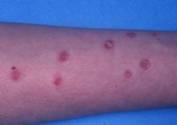 For more information on ringworm, see the Worms & Germs post Ringworm: Skin fungus by any other name. The photos here show ringworm lesions on a person’s arm and on a cat’s face, respectively. (Photo credits: A. Yu, Ontario Veterinary College)
For more information on ringworm, see the Worms & Germs post Ringworm: Skin fungus by any other name. The photos here show ringworm lesions on a person’s arm and on a cat’s face, respectively. (Photo credits: A. Yu, Ontario Veterinary College)
 Over the past several years, studies have shown that many environmental disinfectants sold and labeled for use against the fungi that cause ringworm (which are called dermatophytes) in animals and people are, in fact, not effective when used in households and veterinary clinics. The problem is the chemicals are typically tested against a suspension of the organisms in a test tube, but in the “real world” the fungi are usually found on small fragments of infected hairs. Its possible that the hair shaft protects the fungus from the actions of some disinfectants.
Over the past several years, studies have shown that many environmental disinfectants sold and labeled for use against the fungi that cause ringworm (which are called dermatophytes) in animals and people are, in fact, not effective when used in households and veterinary clinics. The problem is the chemicals are typically tested against a suspension of the organisms in a test tube, but in the “real world” the fungi are usually found on small fragments of infected hairs. Its possible that the hair shaft protects the fungus from the actions of some disinfectants.
There are a few disinfectants that have been shown to be effective against dermatophytes even when they are found on infected hairs and skin cells in the environment. The most readily available one is household bleach, used at concentrations of 1:10 to 1:100. Other effective products include Virkon-S® (a detergent-peroxide based product) and Peroxigard® (an accelerated hydrogen peroxide product) . An environmental spray containing enilconazole (an antifungal agent that is also found in the topical medication Imaverol®) was also found to be very effective. This product is not approved for household use, but it is approved for use in catteries. It is also licensed as a topical treatment for dogs and horses in most of Europe and Canada.
Eliminating ringworm from the household or clinic environment can be difficult, because the fungus can be found anywhere that an infected animal (or person) sheds hair or skin cells. Here are some guidelines for environmental disinfection of dermatophytes:
- All bedding, brushes, combs, rugs, cages, etc. should be vacuumed, scrubbed, and washed with hot water, detergent, and 1:100 chlorine laundry bleach, or another effective disinfectant (see above). It is best to throw out any items that cannot be thoroughly disinfected.
- Walls, floors, lamps, etc. should be scrubbed and cleaned in a similar manner.
- Carpeted areas may be impossible to effectively decontaminate. If possible, remove the carpet and either wash in hot water and bleach, or discard it. Otherwise, frequent vacuuming with immediate disposal of the collection bag is necessary.
- Vehicle interiors should be decontaminated as much as possible in a similar manner.
- Curtains can be “dry-cleaned” at a professional cleaner.
- Clean heating vents (from the house furnace) as well as possible. If the house is heated by hot air, change the furnace filter once weekly throughout the decontamination process.
- Cleaning and disinfection of the environment should be repeated at least once every 4-6 weeks (the more often, the better) until all affected animals and people have eliminated the fungal infection.
Obviously, environmental clean-up for ringworm is quite an undertaking. If infection can be identified early, lesions can potentially be kept covered and movement of pets can be restricted to reduce the extent and amount of environmental contamination.
Special thanks to Dr. Anthony Yu (one of the veterinary dermatologists at the Ontario Veterinary College) for providing much of the information in this post, as well at the photos.